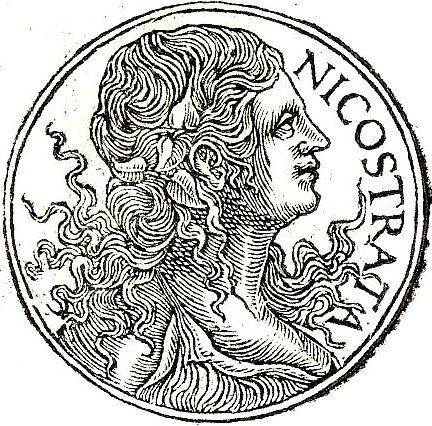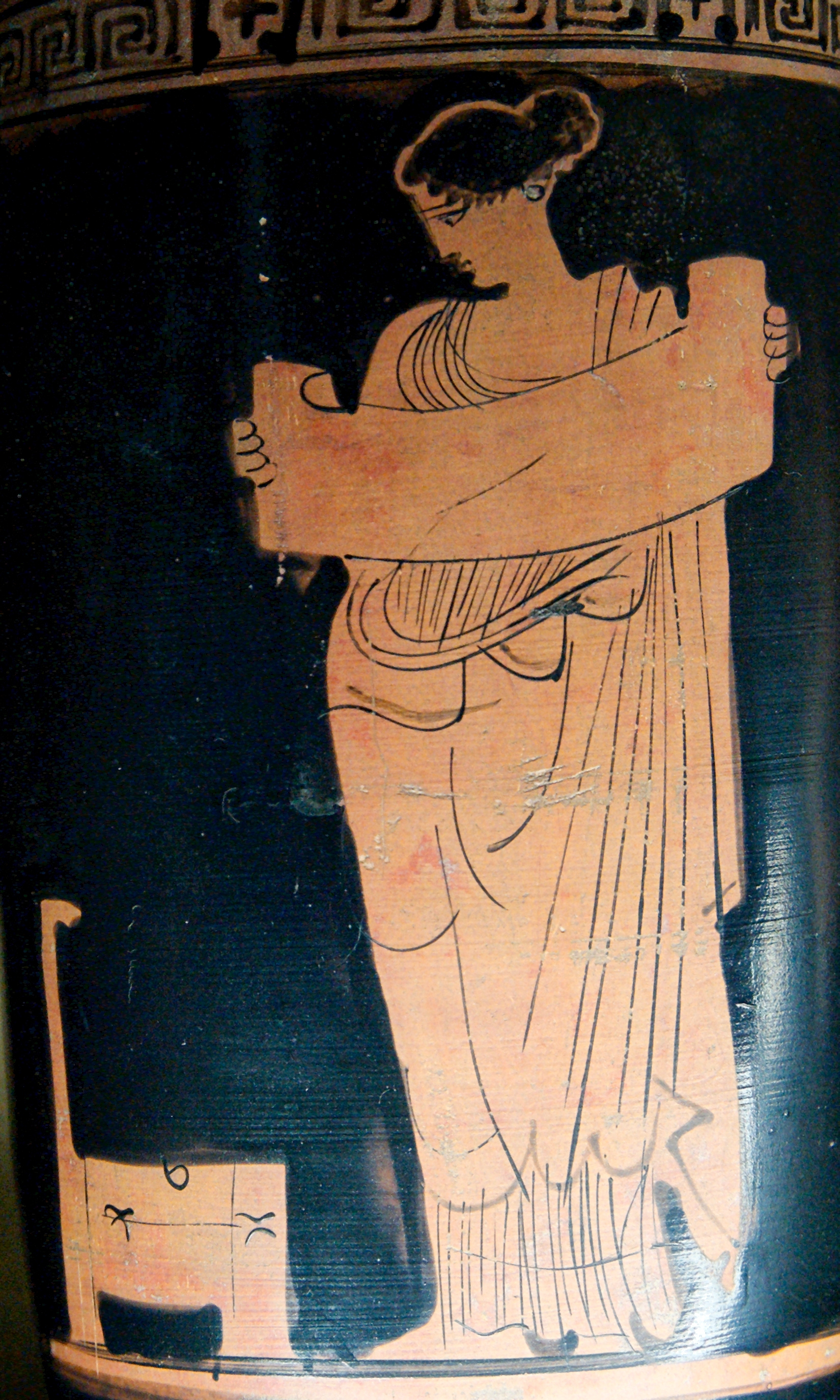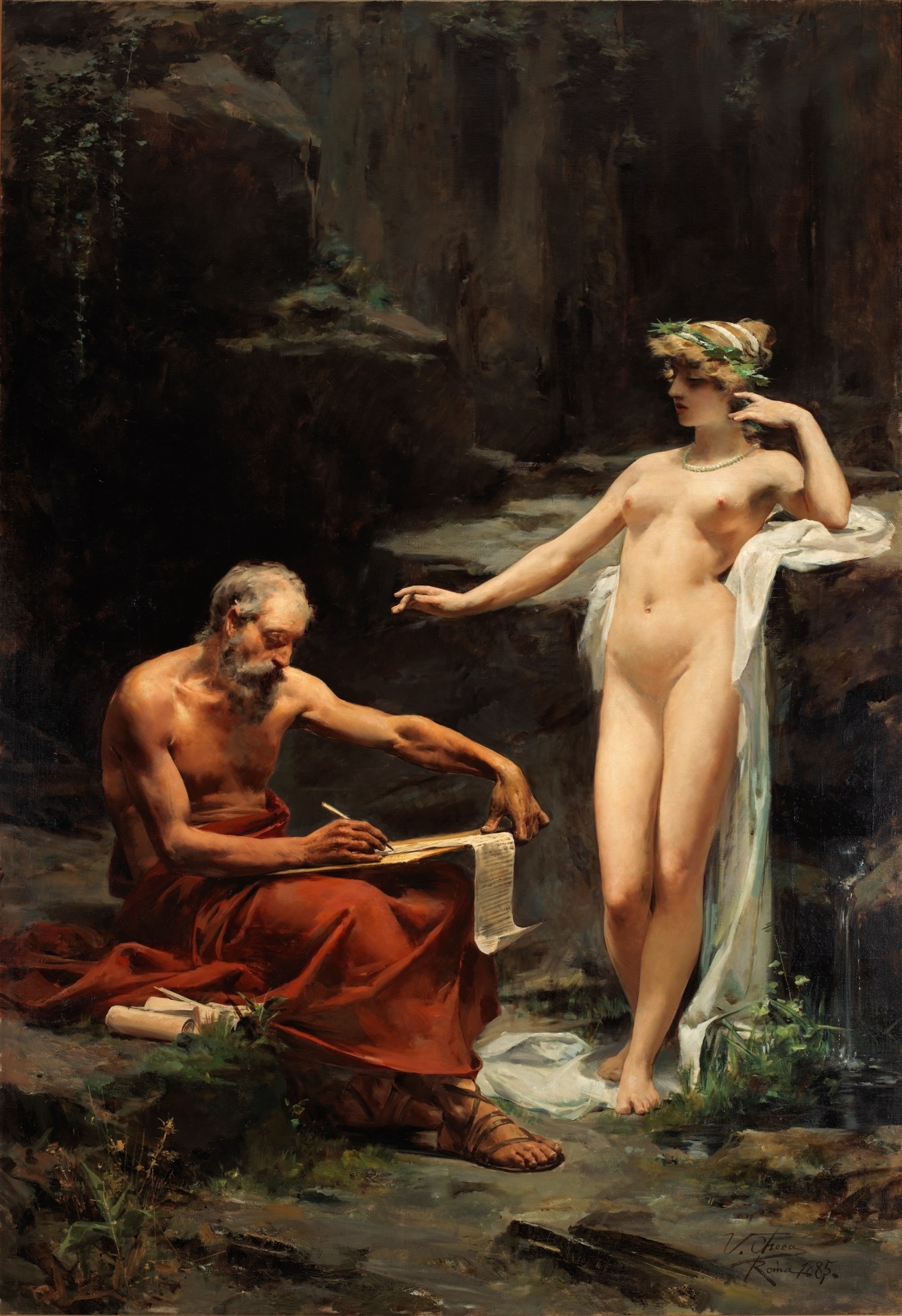|
Camenae
In Roman mythology, the Camenae (also ''Casmenae'', ''Camoenae'') were originally goddesses of childbirth, wells and fountains, and also prophetic deities. Mythology Some mythological figures associated with the Camenae include: *Carmenta, or Carmentis * Egeria, or Ægeria, or Aegeria *Antevorta, or Porrima, or Prorsa * Postverta, or Postvorta The last two were sometimes specifically referred to as the Carmentae and in ancient times might have been two aspects of Carmenta rather than separate figures; in later times, however, they are distinct beings believed to protect women in labor. It is not clear whether these were in fact Camenae themselves, or just closely connected to them. Relationship with the Muses The Camenae were later identified with the Greek Muses. The first instance of this is in Livius Andronicus' translation of Homer's ''Odyssey'', rendering the Greek word ''Mousa'' (Μοῦσα) as ''Camena''. Horace refers to poetic inspiration as the "soft breath of the G ... [...More Info...] [...Related Items...] OR: [Wikipedia] [Google] [Baidu] |
Roman Goddesses
The Roman deities most widely known today are those the Romans identified with Greek counterparts, integrating Greek myths, iconography, and sometimes religious practices into Roman culture, including Latin literature, Roman art, and religious life as it was experienced throughout the Roman Empire. Many of the Romans' own gods remain obscure, known only by name and sometimes function, through inscriptions and texts that are often fragmentary. This is particularly true of those gods belonging to the archaic religion of the Romans dating back to the era of kings, the so-called "religion of Numa", which was perpetuated or revived over the centuries. Some archaic deities have Italic or Etruscan counterparts, as identified both by ancient sources and by modern scholars. Throughout the Empire, the deities of peoples in the provinces were given new theological interpretations in light of functions or attributes they shared with Roman deities. A survey of theological groups as ... [...More Info...] [...Related Items...] OR: [Wikipedia] [Google] [Baidu] |
Postverta
In Roman mythology, Postverta or Postvorta was the goddess of the past and one of the two Carmentes (along with her sister Antevorta, or Prorsa, a contracted form of ''Proversa''). They were companions of the goddess Carmenta, and probably embodied her aspects as the goddess of the past (Postvorta) and the future (Antevorta, or Prorsa). During childbirth, prayers were offered to summon the Carmentes to preside over the labor.Varro, cited by Aulus Gellius in his ''Attic Nights'', XVI. 16 Porrima was said to be present at the birth when the baby was born head-first; Postverta, when the feet of the baby came first. See also *Camenae * List of Roman birth and childhood deities In ancient Roman religion, birth and childhood deities were thought to care for every aspect of conception, pregnancy, childbirth, and child development. Some major deities of Roman religion had a specialized function they contributed to this ... References External linksMyth Index - Postverta Ch ... [...More Info...] [...Related Items...] OR: [Wikipedia] [Google] [Baidu] |
Carmenta
In ancient Roman religion and myth, Carmenta (Greek) or Carmentis (Latin) was a goddess of childbirth and prophecy, associated with technological innovation, specifically, the invention or adaptation of the Latin alphabet as well as the protection of mothers and children and a patron of midwives. Background The name ''Carmenta'' is derived from Latin '' carmen'', meaning a magic spell, oracle or song, and also the root of the English word ''charm''. Her original name was Nicostrate (, "victory-army"), but it was changed later to honor her renown for giving oracles (Latin singular: ''carmen''). She was the mother of Evander of Pallene (fathered by Hermes) and, along with other Greek followers, they founded the town of Pallantium which later was one of the sites of the start of Rome. Gaius Julius Hyginus (''Fab. 277'') mentions the legend that it was she who altered fifteen letters of the Greek alphabet to become the Latin alphabet which her son Evander introduced into Lati ... [...More Info...] [...Related Items...] OR: [Wikipedia] [Google] [Baidu] |
Naiad
In Greek mythology, the naiads (; ), sometimes also hydriads, are a type of female spirit, or nymph, presiding over fountains, wells, springs, streams, brooks and other bodies of fresh water. They are distinct from river gods, who embodied rivers, and the very ancient spirits that inhabited the still waters of marshes, ponds and lagoon-lakes such as pre- Mycenaean Lerna in the Argolis. Etymology The Greek word is ( ), plural ( ). It derives from (), "to flow", or (), "body of flowing water". Mythology Naiads were often the object of archaic local cults, worshipped as essential to humans. Boys and girls at coming-of-age ceremonies dedicated their childish locks to the local naiad of the spring. In places like Lerna their waters' ritual cleansings were credited with magical medical properties. Animals were ritually drowned there. Oracles might be situated by ancient springs. Naiads could be dangerous: Hylas of the '' Argo''’s crew was lost when he was taken by n ... [...More Info...] [...Related Items...] OR: [Wikipedia] [Google] [Baidu] |
Crinaeae
In Greek mythology, the Krenaiai (; , from Greek " κρήνη") are nymph A nymph (; ; sometimes spelled nymphe) is a minor female nature deity in ancient Greek folklore. Distinct from other Greek goddesses, nymphs are generally regarded as personifications of nature; they are typically tied to a specific place, land ...s associated with springs.Larson, pp. 8, 362. See also * Camenae * Pegaeae Notes References * Larson, Jennifer (2001), ''Greek Nymphs: Myth, Cult, Lore'', Oxford University Press, 2001. . Naiads {{Greek-deity-stub ... [...More Info...] [...Related Items...] OR: [Wikipedia] [Google] [Baidu] |
Gnaeus Naevius
Gnaeus Naevius (; c. 270 – c. 201 BC) was a Roman epic poet and dramatist of the Old Latin period. He had a notable literary career at Rome until his satiric comments delivered in comedy angered the Metellus family, one of whom was consul. After a sojourn in prison he recanted and was set free by the tribunes (who had the tribunician power, in essence the power of habeas corpus). After a second offense he was exiled to Tunisia, where he wrote his own epitaph and committed suicide. His comedies were in the genre of Palliata Comoedia, an adaptation of Greek New Comedy. A soldier in the Punic Wars, he was highly patriotic, inventing a new genre called '' Praetextae Fabulae'', an extension of tragedy to Roman national figures or incidents, named after the '' Toga praetexta'' worn by high officials. Of his writings there survive only fragments of several poems preserved in the citations of late ancient grammarians ( Charisius, Aelius Donatus, Sextus Pompeius Festus, Aulus Gell ... [...More Info...] [...Related Items...] OR: [Wikipedia] [Google] [Baidu] |
Muses
In ancient Greek religion and Greek mythology, mythology, the Muses (, ) were the Artistic inspiration, inspirational goddesses of literature, science, and the arts. They were considered the source of the knowledge embodied in the poetry, lyric poetry, lyric songs, and myths that were related orally for centuries in ancient Greek culture. The number and names of the Muses differed by region, but from the Classical Greece, Classical period the number of Muses was standardized to nine, and their names were generally given as Calliope, Clio, Polyhymnia, Euterpe, Terpsichore, Erato, Melpomene, Thalia (Muse), Thalia, and Urania. In modern figurative usage, a muse is a Muse (source of inspiration), person who serves as someone's source of artistic inspiration. Etymology The word ''Muses'' () perhaps came from the Indo-European ablaut#Proto-Indo-European, o-grade of the Proto-Indo-European language, Proto-Indo-European root (the basic meaning of which is 'put in mind' in verb formati ... [...More Info...] [...Related Items...] OR: [Wikipedia] [Google] [Baidu] |
Aegeria
Egeria (, ) was a nymph attributed a legendary role in the early history of Rome as a divine consort and counselor of Numa Pompilius, the second king of Rome, to whom she imparted laws and rituals pertaining to ancient Roman religion. Her name is used as an eponym for a female advisor or counselor. Origin and etymology Egeria may predate Roman myth: she could have been of Italic origin in the sacred forest of Aricia in Latium, her immemorial site, which was equally the grove of Diana Nemorensis ("Diana of Nemi"). At Aricia there was also a Manius Egerius, a male counterpart of Egeria. The name ''Egeria'' has been diversely interpreted. Georges Dumézil proposed it came from ''ē-gerere'' ("bear out"), suggesting an origin from her childbirth role. It may mean "of the black poplar" (Greek αἴγειρος, ''aigeiros''). Her role as prophetess and author of "sacred books" is similar to the Etruscan Vegoia, to whom were attributed various books of prophecy, including the "Li ... [...More Info...] [...Related Items...] OR: [Wikipedia] [Google] [Baidu] |
Antevorta
In ancient Roman religion, Antevorta was a goddess of the future, also known as Porrima or Prorsa (a contracted form of ''Proversa''). She and her sister Postverta (or Postvorta) were described as companions or siblings of the goddess Carmenta, sometimes referred to as "the Carmentae". They may have originally been two aspects of Carmenta, namely those of her knowledge of the future and the past (compare the two-faced Janus). Antevorta and Postvorta had two altars in Rome and were invoked by pregnant women as protectors against the dangers of childbirth.Varro, cited by Aulus Gellius in his ''Attic Nights'', XVI. 16 Antevorta was said to be present at the birth when the baby was born head-first; Postverta, when the feet of the baby came first. Star name Antevorta is an alternative star name for Gamma Virginis, officially named Porrima. See also * Atropos * Camenae * List of Roman birth and childhood deities * Skuld Skuld ("debt" or "obligation"; sharing etymology with the Eng ... [...More Info...] [...Related Items...] OR: [Wikipedia] [Google] [Baidu] |
Egeria (mythology)
Egeria (, ) was a nymph attributed a legendary role in the early history of Rome as a divine consort and counselor of Numa Pompilius, the second king of Rome, to whom she imparted laws and rituals pertaining to ancient Roman religion. Her name is used as an eponym for a female advisor or counselor. Origin and etymology Egeria may predate Roman myth: she could have been of Italic origin in the sacred forest of Aricia in Latium, her immemorial site, which was equally the grove of Diana Nemorensis ("Diana of Nemi"). At Aricia there was also a Manius Egerius, a male counterpart of Egeria. The name ''Egeria'' has been diversely interpreted. Georges Dumézil proposed it came from ''ē-gerere'' ("bear out"), suggesting an origin from her childbirth role. It may mean "of the black poplar" (Greek αἴγειρος, ''aigeiros''). Her role as prophetess and author of "sacred books" is similar to the Etruscan Vegoia, to whom were attributed various books of prophecy, including the "L ... [...More Info...] [...Related Items...] OR: [Wikipedia] [Google] [Baidu] |
Greek Mythology
Greek mythology is the body of myths originally told by the Ancient Greece, ancient Greeks, and a genre of ancient Greek folklore, today absorbed alongside Roman mythology into the broader designation of classical mythology. These stories concern the ancient Greek religion's view of the Cosmogony, origin and Cosmology#Metaphysical cosmology, nature of the world; the lives and activities of List of Greek deities, deities, Greek hero cult, heroes, and List of Greek mythological creatures, mythological creatures; and the origins and significance of the ancient Greeks' cult (religious practice), cult and ritual practices. Modern scholars study the myths to shed light on the religious and political institutions of ancient Greece, and to better understand the nature of mythmaking itself. The Greek myths were initially propagated in an oral tradition, oral-poetic tradition most likely by Minoan civilization, Minoan and Mycenaean Greece, Mycenaean singers starting in the 18th century&n ... [...More Info...] [...Related Items...] OR: [Wikipedia] [Google] [Baidu] |
Livius Andronicus
Lucius Livius Andronicus (; ; ) was a Greco-Roman dramatist and epic poet of the Old Latin period during the Roman Republic. He began as an educator in the service of a noble family, producing Latin translations of Greek works, including Homer's ''Odyssey''. The translations were meant, at first, as educational devices for the school which he founded. He also wrote works for the stage—both tragedies and comedies—which are regarded as the first dramatic works written in the Latin language. His comedies were based on Greek New Comedy and featured characters in Greek costume. Thus, the Romans referred to this new genre by the term comoedia palliata or fabula palliata, meaning "cloaked comedy," the pallium being a Greek-style cloak. The Roman biographer Suetonius later coined the term "half-Greek" of Livius and Ennius (referring to their genre, not their ethnic backgrounds). The genre was imitated by later generations of playwrights, and Andronicus is accordingly regarded ... [...More Info...] [...Related Items...] OR: [Wikipedia] [Google] [Baidu] |







